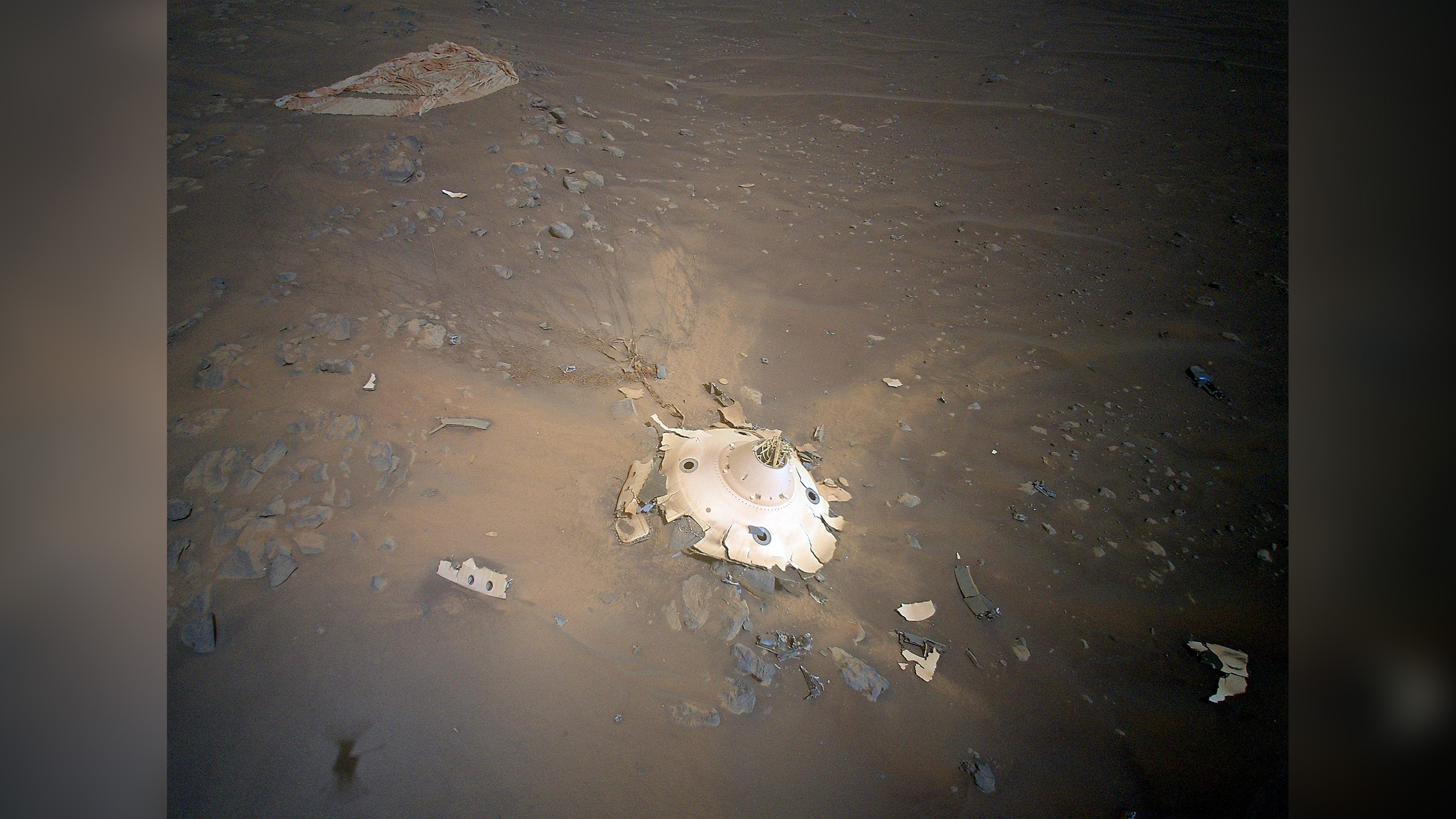Mars helicopter photographs wreckage of its own landing gear in eerily desolate image
The first free-flying helicopter on another planet is providing unprecedented views.

The Mars helicopter Ingenuity has snapped eerily desolate photographs of the spent parachute and backshell that conveyed it to the Red Planet.
The unprecedented images, which look like scenes from an apocalyptic sci-fi movie, come courtesy of the little helicopter's 19th flight on Tuesday (April 26). They show the apparatus that protected the helicopter and the Perseverance rover as they made their hair-raising descent to the Martian surface on Feb. 18, 2021. NASA scientists hope the images will help them understand how the craft handled the descent and inspire future improvements to the process. The hope is that a future mission to Mars will be able to return samples collected by the Perseverance rover to Earth.
"Perseverance had the best-documented Mars landing in history, with cameras showing everything from parachute inflation to touchdown," Ian Clark, former Perseverance systems engineer and now Mars Sample Return ascent phase lead at NASA's Jet Propulsion Laboratory, said in a statement. "But Ingenuity’s images offer a different vantage point. If they either reinforce that our systems worked as we think they worked or provide even one dataset of engineering information we can use for Mars Sample Return planning, it will be amazing. And if not, the pictures are still phenomenal and inspiring."
The images were taken from about 26 feet (8 meters) above the ground. Ingenuity took off at 11:37 a.m. local Mars time, according to NASA, and flew for 159 seconds. During that time, it traveled 1,181 feet (360 meters) and snapped 10 photographs.
"To get the shots we needed, Ingenuity did a lot of maneuvering," Håvard Grip, chief pilot of Ingenuity at JPL, said in the statement. Previous flights had demonstrated that the helicopter and its pilots could handle the aerial acrobatics, however, he said.
The images show the backshell, a saucer-like structure that covered Ingenuity and Perseverance on their final descent, and the parachute, which slowed the craft as it approached the Martian surface. At 1.3 miles (2.1 kilometers) altitude, the rover, helicopter and their powered descent stage detached from the backshell and parachute. The landing engines on the descent stage further slowed the rover and helicopter, guiding them to a gentle landing.
The parachute and backshell, in the meantime, hit the ground at about 78 mph (126 km/h). The new images show the resulting wreckage. The protective coating on the backshell seems to have survived the fiery entry into the Martian atmosphere, according to NASA. The high-strength suspension cables connecting the backshell to the parachute snake across the soil and appear intact. A third of the 70.5-foot (21.5 m) parachute is visible and also appears undamaged.
Sign up for the Live Science daily newsletter now
Get the world’s most fascinating discoveries delivered straight to your inbox.
The Perseverance rover also recently photographed the wreck from the ground, showing the debris dwarfed by Martian slopes, NASA reported.
During its time on Mars, the Ingenuity helicopter has now spent 49 minutes flying and traveled 3.9 miles (6.2 km) in total, according to NASA. Flight 27 is set for the Séítah ridge in the Jezero crater dry river valley. This area represents the remnants of a river delta that once spilled into a lake in the Jezero crater when the Mars surface was wet. A key goal of the current mission is to search for signs that ancient Martian life may have existed in the ancient delta. Ingenuity's job will be to get a bird's-eye view of the topography around the ridge, in part to scout a route to the top of the delta for Perseverance. The helicopter will also survey areas the rover can't reach and potentially hunt for spots where the rover can cache geological samples for an eventual return to Earth.
Originally published on Live Science.

Stephanie Pappas is a contributing writer for Live Science, covering topics ranging from geoscience to archaeology to the human brain and behavior. She was previously a senior writer for Live Science but is now a freelancer based in Denver, Colorado, and regularly contributes to Scientific American and The Monitor, the monthly magazine of the American Psychological Association. Stephanie received a bachelor's degree in psychology from the University of South Carolina and a graduate certificate in science communication from the University of California, Santa Cruz.









